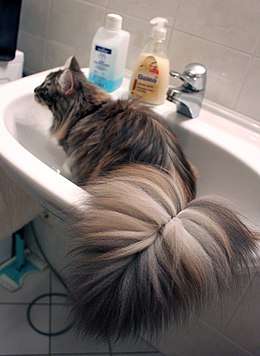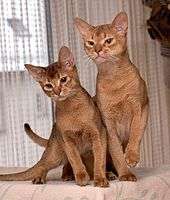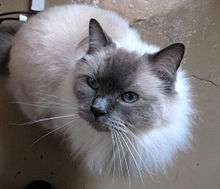Puppy cat

Puppy cat (or puppy-like cat, dog-like cat, etc.) is a term used to refer to specific breeds of domestic cats that have unusual behavioral tendencies that are reminiscent of young domestic dogs. These are within the scope of feline behavior, and may be enhanced through selective breeding. These behaviors, not specific to any breed, include following people around from room to room, the desire to receive frequent moments of physical affection such as being held and petted, a lack of aggression toward some fellow animals, and a placid nature. While these attributes are found desirable for owners interacting with their cats, problems can occur when the felines are exposed to dogs and strange people, with the cats possibly being too trusting and too friendly for their own good.[1] Breeds known for these canine behaviors include the Abyssinian, Burmese, Maine Coon, Manx, and Ragdoll, though dog behavior traits can appear regardless of breed.[2]
Breeds
The cultural assumption that cats are distant from people and lack affection compared to dogs has complications.[3] Animals have individual characteristics based on their environment, particularly their past interactions with people.
The feline temperament is particularly malleable to a wide set of environmental factors, especially sudden stresses. For example, after dangerous floods in Canvey Island, cats showed behaviors of psychological shock akin to human struggles.[3] Well-raised kittens frequently demonstrate affection towards humans and a pleasant, docile nature regardless of pedigree. These broad traits are not specific to any particular breed, as the upbringing of the animal is an important factor. Positive interaction with humans in the first few months of life is particularly vital.[4]
Most feline pets in the United States are considered to be domestic short-haired cats, a catch-all term for those with mixed or otherwise unclear ancestries but having related appearances. Several of those cats, or those of the standardized American Shorthair breed, will respond differently to others despite looking very similar, displaying dog-like or otherwise unexpected tendencies. Besides breed-based generalizations, a particular cat's behavior can be assessed by its restraint in using claws during play, its tendency to follow people, and its appreciation of close and frequent human contact.
Abyssinian

Abyssinian cats are known for demanding attention and showing depression if left alone too often. The closeness to their owners causes some of them to respond positively to feline leash-training. Unlike most cats, Abyssinians often show interest in water rather than a fear of it. A frequently active breed, Abyssinians will often climb upon their owners and perch upon their bodies to see. They also tend to welcome the company of friendly-minded dogs.[5][6]
Veterinarian Joan O. Joshua has said the "dog-like attachment to the owners" of Abyssinians causes "greater dependence on human contacts". This stands in contrast to the mere "tolerant acceptance of human company" based on "comforts" that multiple other breeds display.[3] With their interest in playing with their owners combined with their curious intelligence, Abyssinians are nicknamed the "Clowns of the Cat Kingdom."[5]
Burmese
The Burmese breed typically displays the dog-like attachment seen in Abyssinians.[3][6] They both also share the combination of high intelligence and tendency to stay close that makes training them to be on a leash practical.[7][8] The Burmese are persistently more vocal than other breeds and express interest in playing games akin to puppies. American and British breeders have developed distinctly different standards for the Burmese, a situation that's unusual among pedigreed cats, and the British type has attracted the colloquial title of 'European Burmese'.
Maine Coon

Maine Coons are, according to Academy of Veterinary Nutrition Technicians President Kara Burns and Dr. Lori Renda-Francis, "often referred to as 'dog like'." This description is not only due to their large size and stature but also because of the cats' usually pleasant mannerisms and tendency to closely follow their owners, and obey them. Maine Coon cats also are often trainable given their intelligence and affectionate nature. The felines have large and silky coats yet grooming is made easier given their desire to be frequently handled.[9][10] The Cat Fanciers' Association said that the dog-like Main Coons offer "hours of enjoyment with their antics", though they are "intrusive" since "[w]ithout question" the cats "want to be [a] part of everything".[9][11]
Manx
The Manx breed shows behaviors like puppies, such as coming when their owners whistle or call their names. They are known for jumping and climbing about obstacles as well as burying things, even collecting and burying toys at times. Manx felines will also display strong affection generally. Dr. David Taylor, writer and founder of the founder of International Zoo Veterinary Group, said they are "positively dog-like".[6][8]
Ragdoll

Ragdolls are named for earlier tendency of the breed to go limp when picked up, and their tendencies to rest in a doll-like, bent position. They usually display a calm, relaxed temperament, with the animals often seeking physical affection from owners and following owners around. They sometime play games such as fetch.[1][12]
See also
References
- 1 2 Benjamin L. Hart; Lynette A. Hart (2013). Your Ideal Cat: Insights Into Breed and Gender Differences in Cat Behavior. Purdue University Press. pp. 99–101. ISBN 9781557536488.
- ↑ Sources for breeds known for canine behaviors:
- Benjamin L. Hart; Lynette A. Hart (2013). Your Ideal Cat: Insights Into Breed and Gender Differences in Cat Behavior. Purdue University Press. pp. 99–101. ISBN 9781557536488.
- Joshua, Joan O. (2013). The Clinical Aspects of Some Diseases of Cats. Elsevier. pp. 1, 23–24. ISBN 9781483226002.
- "Top Three Dog-Like Cat Breeds". Pet MD. Retrieved September 11, 2016.
- "Maine Coon Cat". Cat Fanciers' Association. Retrieved September 11, 2016.
- Kara Burns; Lori Renda-Franci (2014). Textbook for the Veterinary Assistant. John Wiley & Sons. ISBN 9781118813768.
- Taylor, David (2011). The Complete Contented Cat. David & Charles. pp. 22, 106. ISBN 9780715336410.
- "Abyssinian". VCA Animal Hospitals. Retrieved September 11, 2016.
- 1 2 3 4 Joshua, Joan O. (2013). The Clinical Aspects of Some Diseases of Cats. Elsevier. pp. 1, 23–24. ISBN 9781483226002.
- ↑ Becker, Mikkel (January 29, 2013). "Your Guide to Socializing a Kitten". vetstreet.com. Retrieved September 11, 2016.
- 1 2 "Abyssinian". VCA Animal Hospitals. Retrieved September 11, 2016.
- 1 2 3 "Top Three Dog-Like Cat Breeds". Pet MD. Retrieved September 11, 2016.
- ↑ O'Flynn, Justine (1997). Guide to Owning a Burmese Cat. T.F.H. Publications. pp. 11–13. ISBN 9780793821693.
- 1 2 Taylor, David (2011). The Complete Contented Cat. David & Charles. pp. 22, 106. ISBN 9780715336410.
- 1 2 "Maine Coon Cat". Cat Fanciers' Association. Retrieved September 11, 2016.
- ↑ Kara Burns; Lori Renda-Franci (2014). Textbook for the Veterinary Assistant. John Wiley & Sons. ISBN 9781118813768.
- ↑ Fawcett, Kirstin (March 11, 2016). "12 Huge Facts About Maine Coons". mentalfloss.com. Retrieved September 9, 2016.
- ↑ "Ragdoll". VCA Animal Hospitals. Retrieved September 11, 2016.